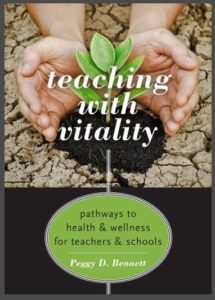
By Peggy D. Bennett, Oberlin OH &
Vicky Suarez, Richardson TX
Reprinted from Southwestern Musician with permission by Texas Music Educators Association.
We love teaching! Yet, being a teacher can deplete us by degrees. The highs are so high, and the lows are so low. Managing to stay emotionally afloat as we interact with students, coworkers, administrators, and parents is no easy task. Schools are ecosystems and any highs or lows, celebrations or tensions, tend to seep through the fabric of our daily teaching lives—and then they follow us home.
Because teaching is such a personal act, we often internalize the ups and downs as if they reflect our character, knowledge, skill, and potential for success. Our responsibilities seem overwhelming and unrealistic, and we often become envious of others’ achievements and accolades. We can feel hurt by overt or covert treatment that we believe is unfair. We can interpret words and behaviors as criticism, even when they are not intended that way. We can feel untethered and out of balance as we vacillate between I can do this! and I can’t do this!
The following are five ideas for regaining equilibrium and being the teacher and colleague we want to be. For each topic we examine attitudes and behaviors that could help you regain your vitality for teaching. We encourage you to incorporate these ideas as experiments in a quest to regain your spirit for teaching and a vitality for healthy interactions with everyone in your schools. Try them and see what happens!
INTERPRET MISBEHAVIOR AS SIMPLY BEHAVIOR
One of the most profound changes we can make in our teaching comes from a unique definition of misbehavior offered by C. M. Charles: misbehavior is knowingly and willingly obstructing, disrupting, or interrupting (1985, p. 4). What would change if we adopted this definition for interpreting students’ behaviors? What would happen if we applied this filter to adults in our schools? If there is no intention to misbehave, should that warrant a different response?
Behavior problems often cause us to become hypervigilant; we pounce on any behavior we see as directly opposing our rules or potentially becoming a problem. Shifting and restricting what constitutes misbehavior alters what we say and what we feel about the behavior challenge confronting us.
Can we fathom that students or adults who annoy us may not be intentionally annoying? Feeling insulted does not necessarily mean someone is knowingly insulting. Feeling a specific emotion does not mean another is guilty of causing it.
What could happen if we changed how we interpreted others’ behaviors? We could more often retain a calm internal and external countenance, allowing us to address the behavior and the consequence matter-of-factly, clearly, and without accusation. Consider this: Sometimes we adults are rude, annoying, unfair, rough, vulgar, or imposing, according to other adults. Does that mean we are misbehaving? When we give up assuming intent, it changes us: we respond differently internally and externally (Ruiz, 1997). We do not necessarily ignore the behavior, but we also do not presume malicious or disrespectful intent. Just as adults have wide ranges of normal behaviors, so do students. Embracing this simple habit of taking a second look can save us from frustration, tension, and heartache.
Redefining misbehavior can allow us these opportunities: we can respond with the appropriate level of assertiveness, give the benefit of the doubt or a moment of grace, identify neutrally what we see and hear, and explain why something needs to change (Bennett & Bartholomew, 1997, pp. 204–213). Consider neutral directives that are informative:
- The noise level is way too high right now. How fast will you fix it?
- I see your hand, Toby, but I’m listening for Jamey’s answer.
- If your voice/instrument is too loud right now, I’m going to assume you are not listening as you sing/play. Let’s see what it sounds like if each of you listens to others as you sing/play.
AIM TO UNDERSTAND RATHER THAN AGREE
When someone agrees with us, we can feel validated and relieved. When someone disagrees with us, we can conjure all sorts of negative reactions. Conflict has the reputation of producing stress, fatigue, paranoia, short-sightedness, and many other dis-eases. Thankfully, we have more power than we may realize to manage those inevitable tensions. A simple antidote to fear and anger during conflict is easily within reach: aim to understand rather than agree (Rusk, 1993).
With conflict, we often jump immediately to conclusions, not only about the action but also about its underlying reasons. That is why we suffer—we think we know the intent of another’s choices (Ruiz, 1997). But if we momentarily suspend our assumptions, we can pursue a path of understanding. Then, we have a broader palette for interpreting disagreement.
Spoken with calm curiosity, not sarcasm, aggression, or confrontation, simple questions and statements like these can pave the path to understanding.
- Can you tell me a little more about what led you to that decision?
- Why do you think that?
- I had a very different reaction. Tell me how you interpreted that.
- What can you tell me that will help me understand what just happened?
Conflicts, large and small, can be reframed by shifting from agreement to understanding. Even if you leave a conflict in disagreement, sharing perspectives with civility and intent to understand will serve you well. If the other person happens to explain without asking your opinion, simply say, “I think I understand your position on this better. Now I’ll tell you my thoughts, so you can understand my perspective as well.” Releasing the pressure valve of conflict in this simple way can refuel each party’s vitality.
RELEARN HOW TO BE PLAYFUL
No matter how many years you’ve been teaching or what ages you teach, an attitude of playfulness can help rebalance a pattern of discouragement. Playfulness steers us toward replacing harsh criticisms or quick judgments with lighthearted responses. (Bennett, 2014)
Adopting playful responsiveness may seem like letting people off the hook for their annoying behaviors. Yet it may also be crafting a quality of interaction that serves both the sender and receiver. Examples of playful commentary could be:
- That wasn’t quite what I had in mind when I said “Grab your folders.”
- Okay, your giggles are interrupting our study. Let’s take five seconds to get the giggles out so we can study the sounds in that piece.
- This lunchroom talk is a little tough on my digestion.
- The students are so fortunate to have such an array of teachers as us!
Important here is to stress what playfulness is not. It is not the teacher telling jokes, entertaining, dominating the lesson, or using sarcasm as humor (Bennett & Bartholomew, 1997, pp. 155–158). Playfulness is instead an eagerness to teach and engage with curiosity, suspended judgment, lighthearted banter, and genuine puzzlement. Beware that if playfulness becomes too clever or too showy, students’ behaviors may escalate rather than comply.
PRESERVING MUSICALITY
Our passion for music and our desire to share music likely motivated us to become music teachers. It should be no surprise, then, that the quality of the music in our classrooms and rehearsals can influence our vitality for teaching!
Musicality, the quality of expression, fluency, and nuance that makes music musical, is at the heart of our passion for music. Yet sometimes it is our quest to teach the intricacy and accuracy of music notation that diminishes the very thing that inspires our passion for music (Bennett, 2016). What a paradox to consider that teaching music can cause us to lose our musicality! How does this happen?
When we turn music reading into an arithmetic drill (beats, note values, measures) and let the notation of music rule its performance, we may be strangling the aesthetics for our students and for ourselves. If this sounds familiar, it may be time to reconnect to musicality in all music classes, for all ages.
Do you teach rhythms and intervals out of context and use arithmetic relationships, rather than sounds that musically and linguistically cluster together, to define patterns to study? Are ensemble warm-ups more routine than musical, more habitual than aesthetic? Are students encouraged to be expressive and nuanced in even the simplest patterns as they sing and play?
- Watch my hands as I conduct your scales. You’ll notice some nuances. Will I hear you match my expressions?
- Sing the song like you’re telling the story. That’s what anyone listening wants to hear: your expressiveness.
- Let’s sing/play the fourth phrase. Disregard the bar lines, because I want you to shape the sound for that cluster of notes. And the cluster doesn’t fit within the bar lines.
- How will you make your hand signs as musical as your singing while you perform that pattern?
Teaching music in lifeless and unmusical ways can wear on our spirits. Prioritizing musicality and expressiveness can revitalize us. We can give ourselves permission to choose music we enjoy and to preserve its musical integrity in our teaching. When we teach what we love, we are passionate about it, and our teaching will reflect that vibrancy.
TAKE YOUR BEST SELF TO SCHOOL
Too easily and too frequently, we can adopt a habit of being in perpetual fight-or-flight mode at school. The stress caused by living in constant anxiety can interfere with sleep, mood, digestion, resilience, and, of course, good teaching.
We can all-too-easily slide into a pattern of seeking (and finding!) behaviors that rile us, people who threaten us, and conflicts that make us want to fight or flee. When we consciously choose the intention to be our best, all sorts of interactions, big and small, shift our focus and recast our feelings. Manifesting our intent each morning can powerfully frame the way we want to behave, react, comment, and care.
The simple yet powerful attitudes and behaviors described here will not eliminate the hard, sometimes wearisome work required of all educators. These ideas can, however, revive you in moments of doubt and vitalize you in the midst of myriad emotional challenges every teaching assignment presents. Regaining the life in your teaching may require the baby steps of experimenting with these dimensions of playfulness, understanding, musicality, behavior, and your best self, but your mental, physical, and social health is worth every step!
REFERENCES
Bennett, P. D. (2016). Questioning the unmusical ways we teach children music (286–307), Teaching general music: Approaches, issues, and viewpoints. Eds. Carlos Abril & Brent Gault. New York: Oxford University Press.
Bennett, P. D. (2014). Playfulness is an attitude: A practice that revitalizes teaching and learning. Alfred Music. Ledger Lines email blast.
Bennett, P. D. & Bartholomew, D. R. (1997). SongWorks 1: Singing in the education of children. Van Nuys, California: Wadsworth. 2014 republished by SongWorks Press.
Charles, C. M. (1985). Building classroom discipline: From models to practice. New York: Longman.
Ruiz, D. M. (1997). The four agreements: A practical guide to personal freedom. San Rafael, California: Amber-Allen Publishing.
Rusk, T. (1993). The power of ethical persuasion. New York: Penguin.
Peggy D. Bennett is Professor Emerita of Music Education at Oberlin Conservatory of Music and is a certified mediator and life coach. Vicky Suarez is an Elementary Music Specialist at Prairie Creek Elementary (Richardson ISD).














